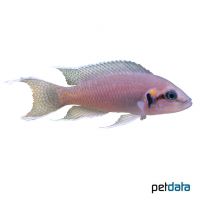Fairy Cichlid (Neolamprologus brichardi)
| Fairy Cichlid Neolamprologus brichardi | |
|---|---|
| Name | Fairy Cichlid |
| Name Lat. | Neolamprologus brichardi |
| Synonym | Lamprologus brichardi |
| Family | Cichlids |
| Family lat. | Cichlidae |
| Order | Cichlids |
| Order lat. | Cichliformes |
| Origin | Lake Tanganyika |
| Habitat | Rocky habitat |
| Diet | Carnivore |
| pH | 7.5-9.0 |
| Behavior | Aggressive |
| Keeping | Pair, group |
| Care Level | Difficult |
| Reproduction | Cave spawner |
| Breeding | Moderately difficult |
| Life Span | 5-8 years |
| Protection | No |
| Metric Units | |
| Size | 9-10 cm |
| Temperature | 24-28 °C |
| Hardness | 15-18 °dH |
| Aquarium | ~ 200 l |
| US Units | |
| Size | 3.5"-4" |
| Temperature | 75-82 °F |
| Hardness | 267-320 ppm |
| Aquarium | ~ 50 gal |
Distribution and habitat
The fairy cichlids are found exclusively (endemically) in the northern part of Lake Tanganyika, where they are widespread and have brought forward some site variants. They live on the rugged coasts in the rocky littoral.
Maintenance
The aquarium setup should have rocky structures reaching the water surface, with plenty of caves, crevices and shelters to provide hiding places, as well as some open sandy areas.
No ammonia, ammonium and nitrite should be detectable, the nitrate value should not exceed 100 mg/l. To ensure the water quality and oxygen content, a filter and heater adapted to the aquarium size is required, as well as lighting for the species-appropriate day-night rhythm of the animals.
Diet
In nature they feed mainly on insects, insect larvae and plankton. The food supply consists of live, frozen and dry food. For a balanced diet, feed once a day with a high-quality dry food for Tanganyika cichlids (flakes, granules, pellets) as well as cyclops, daphnia, artemia, mosquito larvae, plankton, etc. (live or frozen)
It is recommended to feed small portions several times a day. Only feed as much as will be eaten within a few minutes. A regular and varied diet promotes health and prevents deficiency symptoms.
Behaviour and compatibility
They are relatively peaceful cichlids and strongly defend their territory during the breeding season. They should be kept in pairs, or better in a group. Keeping several pairs or a group is only recommended in a larger and richly structured tank. They can be well socialized with other small and medium-sized cichlids from Lake Tanganyika.
Basically, only compatible fish species with similar demands on water condition and water temperature should be socialized.
Sex dimorphism
The sexes are difficult to distinguish. Adult males have a longer extended dorsal and caudal fin.
Reproduction and breeding
They are pair-building cave breeders and usually attach the spawn to the cave ceiling or walls. The female performs brood care while the male defends the territory. The fry hatch after 2-3 days and swim free after 6-8 days. The fry remain in the parent's territory even when the parent spawns again and help raise the younger siblings. Thus, a colony can soon form that displaces other species.
Fry must be fed several times a day with special rearing food (Artemia nauplii). In community tanks breeding is hardly possible, because the young fish are easy prey.
Important
Different site varieties should not be maintained together as they can cross (hybridize).
The well-being of the fish should be checked regularly. Temperature should be checked daily, pH, hardness and nitrate levels at least fortnightly. Regular partial water changes are recommended, even if the contaminant level has not yet reached the upper limit. Sudden changes in water quality should be avoided. Newly introduced fish must be accustomed slowly to the water in the aquarium.
Further literature can be found in your pet store.
References
Text: Werner Winter; Image: petdata
Source: BMELV (1998): Tierschutzgutachten - Haltung von Zierfischen (Süßwasser); RIEHL & BAENSCH (2006): Aquarien Atlas Bd. 1, Mergus Verlag; ENGELMANN (2005): Zootierhaltung - Tiere in menschlicher Obhut: Fische, Verlag Harri Deutsch
- Gemäß § 21 Abs. 5 Tierschutzgesetz idgF
